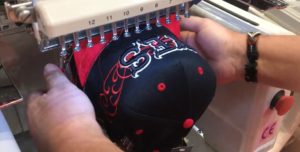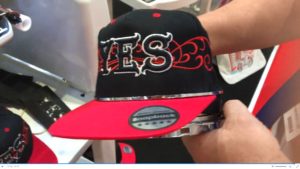 3D embroidery is not actually that new. John-Paul Burton, director, Your Embroidery Services Ltd reports on this market-opening technique.
3D embroidery is not actually that new. John-Paul Burton, director, Your Embroidery Services Ltd reports on this market-opening technique.
3D embroidery has been around, with varying success, for more than a couple of decades. Strangely, although machinery and software etc. have advanced at a fair rate, the technique for this type of embroidery has remained fairly static.
There are three basic methods of achieving the raised appearance that defines 3D embroidery:
- Appliqué style.
- Injection
- Foam (probably the most used these days).
Whichever method is used there are some basics that you need to be aware of.
Firstly, and probably most importantly, the raising agent used must match the launderability and durability of the garment or other product.
Secondly it should give the effect of 3D without giving away how this is achieved. An example of this would be using a raising agent with a contrasting colour (black foam covered with white thread on a white garment).
Thirdly it must be cost efficient. Make sure that you know the prices of all the raw materials and that you have costed it correctly. Remember that 3D embroidery not only takes extra product but it increases the production time.
So, let’s have a look at each method in more detail.
Appliqué style
This is used infrequently as it is quite an expensive way of creating the effect and, in truth, creates more of a raised effect than a true 3D. The finished embroidery is built up using different layers of appliqué fabric together with the embroidery thread.
To imagine this think about a circle of appliqué fabric that has decorative stitching around the edge. On top of this is added a second smaller piece for fabric which is embroidered appropriately. Once you add a third and, maybe, a fourth piece you have an embroidery that gradually rises towards the middle. A sort of flattish wedding cake design.
As you can see this is a very laborious technique but has been used in fashion for many years and so should not be discounted.
Injection
This is rarely used these days as it can present numerous problems but it is still worth looking at. The embroidery is created using very loose stitches or by using a ‘bubble’ of appliqué fabric.
Once this initial stage is complete a padding or wadding is injected, using a special device and compressed air, under the embroidery. This method can be quite troublesome as it requires a lot of stitches to ensure that the wadding cannot be seen.
The devices are also quite difficult to get hold of and, although this method is worth a mention, it is not a technique that comes highly recommended.
Foam
This is by far the most popular, and the most effective, way of creating a true 3D embroidery.
An easy-cut foam forms the basis of the 3D effect. It is laid on the garment or cap and the embroidery stitches are the sewn through it. Once the design is finished the excess foam is torn away. It comes away quite easily as the needle entry pints perforate the foam which rips cleanly along the stich line. You cannot just use any design though. It must be created with the raised effect in mind. This is most important where the stitch count is concerned. It is imperative that the foam is completely hidden and so the stitch density needs to be higher than for a standard design.
Foam can also be used with appliqué fabrics which, of course, will save on stiches and production time. Neither is better than the other. It is more a case of design and customer requirement.
 Whichever system you use it is important to get the fundamentals right. Good preparation and design can save you lots of time and money but will give you a high quality result and, most importantly, a satisfied customer.
Whichever system you use it is important to get the fundamentals right. Good preparation and design can save you lots of time and money but will give you a high quality result and, most importantly, a satisfied customer.
Just a word of warning where the foam is concerned. Don’t be tempted to use just any old piece of packaging that came with the last Amazon delivery. The foam used for 3D embroidery has been researched and will work. It will launder well and will rip cleanly away.
3D embroidery may not be a market leading technique at the moment but that is probably because the end sellers think it not cost effective or durable. Convince them otherwise and you have opened up a whole new market for yourself.
 Printwear & Promotion The Total Promotional Package
Printwear & Promotion The Total Promotional Package




